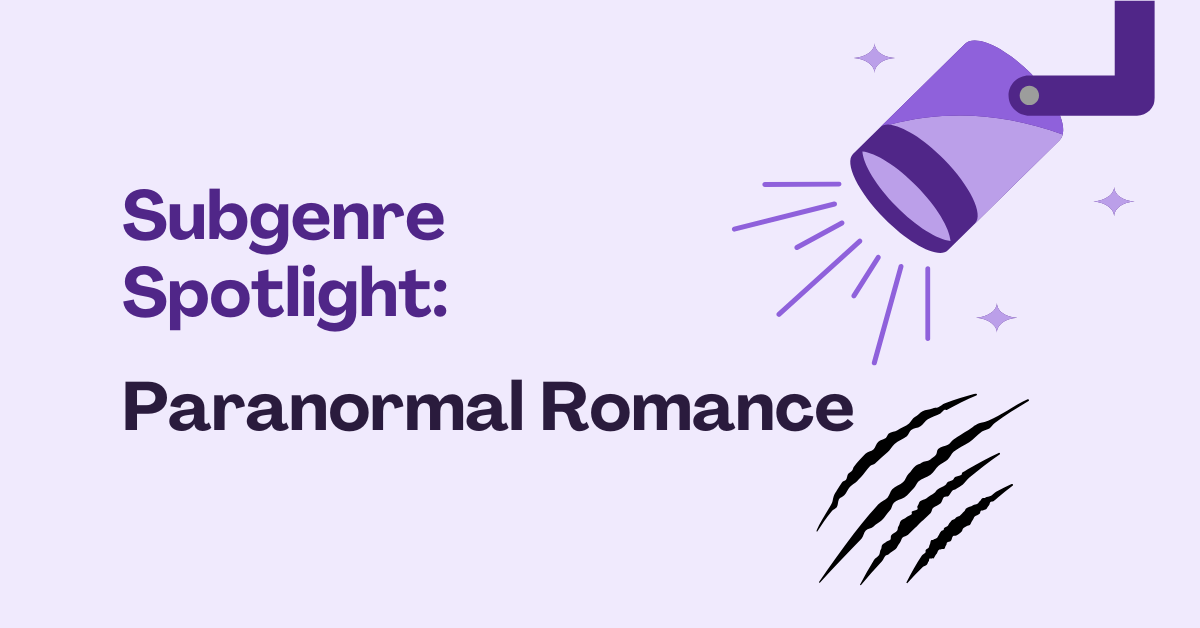Subgenre Spotlight: Paranormal Romance
Halloween is almost here, so I'm kicking off my new Subgenre Spotlight series with the spookiest of subgenres: Paranormal Romance.

Halloween is almost here, so I'm kicking off my new Subgenre Spotlight series with the spookiest of subgenres: Paranormal Romance.
Paranormal Romance is a subgenre of romance fiction that features a central love story with an emotionally satisfying ending (as per the Romance Writers of America definition of romance novels) and paranormal element are integral to the plot. Typically, these stories involve supernatural beings like werewolves (and other shapeshifters), vampires, witches and demons, and often include themes of magic, immortality and otherworldly abilities.
In each spotlight post, I will share data I was able to find or gather about the subgenre. For this subgenre, that includes:
- Notable Book Series
- Web Search Trends
- Number of Books
- Bestseller Analysis
- Social Media Hashtags
- Additional Resources
Note: Commissions may be earned from the links on this page.
Notable Book Series
Here is a list of some of the notable series in Paranormal Romance, along with when they debuted:
- September 2005: The Black Dagger Brotherhood by J.R. Ward
- September 2005: The Twilight Saga by Stephenie Meyer
- February 2006: Immortals After Dark by Kresley Cole
- September 2006: Psy-Changeling by Nalini Singh
- February 2011: All Souls (A Discovery of Witches) by Deborah Harkness
- May 2015: A Court of Thorns and Roses by Sarah J. Maas (usually falls under Fantasy Romance, but is sometimes categorized as Paranormal Romance)

Please note that this is not a definitive list—it's based on books that appeared on the Best of the Best Romance Books of All Time list and series that have consistently been mentioned during my romance education.

Web Search Trends
Using Google Trends, we can gauge the level of interest in Paranormal Romance over the past 20 years by looking at the popularity of web searches on this topic. As you can see below, the search term "paranormal romance" starts to take off around 2005 to 2006. Looking at the list of notable series above, this timing aligns with the publishing of several foundational series of the subgenre.
The Rise
As researcher Maria Ramos-Garcia points out in her paper, From Contemporary to Dystopian Fiction: The Changing Realities in Paranormal Romance, several authors had started publishing their "vampire-lover fictions" at least 15 years before the advent of Twilight—so this trend had been brewing for some time. She also notes the undeniable influence of the popular TV series Buffy the Vampire Slayer (1997-2003) and its spinoff Angel (1999-2004).
Ramos-Garcia further explains, "As I have pointed out elsewhere, in addition to the 1990’s precursors and the influence of Buffy, the effect that the attacks of September 11th and their aftermath had in the American consciousness and its perception of the world at large seems to be at play in this literary boom as well."
According to this theory, the increased interest in Paranormal Romance was a response to the fear and uncertainty felt by Americans after 9/11—readers were seeking some sense of security and comfort.
Romance author Sarah MacLean discusses this theory in the inaugural episode of the podcast Fated Mates, hosted by her and romance critic/editor Jen Prokop, saying: "There was a huge burst of paranormal romances where the heroes, and in [some cases] the heroines too, were these enormously larger than life and literally immortal beings who could save the world."
The Decline
The popularity of the search term hits its peak in January 2012. What was happening in the six months leading up to this apex? Two things of note:
- June 2011: Erotic romance novel Fifty Shades of Grey was published, which is generally acknowledged to have had a significant impact on the publishing industry.
- November 2011: The Twilight movie series, based on the blockbuster paranormal romance book series, was nearing its end with the release of its penultimate movie, The Twilight Saga: Breaking Dawn - Part 1.
Number of Books
As I discuss in Book Data Difficulties, it's impossible to get accurate data on the number of books published each year. So I did some research to see what other sources I could find.
romance.io is the largest romance-only book website and houses a database of 600,000+ romance books. It also features the Romance Book Finder, a fantastic interface that allows users to filter results by a vast array of tags, covering everything from subgenres, tropes, steam level, content warnings and much more.
Paranormal Romance Subgenre
Using this tool, I was able to compare how many romance books from the past 20 years have been tagged as Paranormal.
As you can see, the subgenre peaks in 2015—a few years after the drop in web search requests. This likely has much to do with the rise of self-publishing. According to an article in Publishers Weekly, by late 2012 the number of self-published books published in the U.S. had risen by 287% since 2006. So while the popularity of Fifty Shades of Grey had a significant impact on the traditional publishing industry, I would speculate that there was less impact on indie authors who were not beholden to the decisions of traditional publishers.
As of 2022, we're starting to see an uptick in Paranormal Romance books again, likely fueled by the huge popularity of A Court of Thorns and Roses (ACOTAR) and Fourth Wing. While these two books/series are often categorized as Fantasy Romance or "Romantasy", they do share some elements that are common in Paranormal Romance (for example, ACOTAR has faeries/fae and Fourth Wing has dragons, gryphons, wyvern and other mythical creatures).
Paranormal Creature Subgenres
I also compared Paranormal Creature subgenres within Paranormal Romance to see how these have shifted over time. Similar to the overall Paranormal subgenre, we see these Creature subgenres peak in 2015 as well. Currently, shapeshifters, vampires and monsters are starting to trend upwards again.
Based on the 2023 figures, we can get a sense of the current popularity of various paranormal creatures:
- Shapeshifters (33%)
- Vampires (17.4%)
- Witches (16.5%)
- Demons (12%)
- Monsters (9%)
- Fae (7.2%)
- Angels (4.9%)
Note: Books can be tagged with multiple Paranormal Creature subgenres.
Bestseller Analysis
As mentioned in my post Book Data Difficulties, Amazon is challenging for gathering book data, but it does have bestseller lists for pretty much every subgenre imaginable (including many duplicate categories—it's so messy!!) and includes self-published books.

So I analyzed the Amazon.com Kindle Store Top 100 Paid Best Sellers in Paranormal Romance list on October 20, 2024 and here's what I found:
Authors
The list had 60% unique authors (60 authors of 100 books). There were 17 authors with multiple titles on the list—the 3 authors with the most titles:
- Caroline Peckham: 11 books
- Jennifer L. Armentrout: 7 books
- J Bree: 6 books
Series
The majority of the books (90%) were part of a series—only 10 of the books were not currently part of a series.
Ratings
The average Amazon rating for the books on the list was 4.45.
Length
The average length of the books on the list was 462 pages. The shortest book was 90 pages and the longest was 1,301 pages.
Publication Year
The majority of the books (55%) were published in 2024. Of the 45% that were published before 2024, about half could be connected to a new release by the same author (usually part of a series). However, there were some anomalies—in particular, author J Bree had all six books of her The Bonds that Tie series on the list, even though the last one was published in 2022. One can assume that the series got a boost from TikTok, as they all sported a "Best of BookTok" label.
Category / Subgenre
Amazon has a lot of categories within the Paranormal subgenre and most books are tagged with 3 categories, so I made a judgment on the main category of each based on the available information. Similar to the popularity of paranormal creatures we saw in the previous section (Number of Books), the category breakdown is as follows:
- Shifters - 37%
- Vampires - 26%
- Witches - 24%
- Other - 13%
Publisher
Using Jane Friedman's list of Key Book Publishing Paths to categorize the type of publisher, the breakdown of publishers is as follows:
- Indie/DIY: 82%
- Assisted/Hybrid: 10%
- Big Five: 5%
- Amazon Publishing: 1%
- Other Traditional: 1%
- Small Presses: 1%
Social Media Hashtags
Instagram and TikTok are the social media platforms of choice for readers, they even have their own nicknames—Bookstagram and BookTok.
Unfortunately, I can't access hashtag trends over time, but I've captured the current number of posts (as of October 25, 2024) for Paranormal Romance-related hashtags on both social media platforms.
- #paranormalromance – Instagram: 801K | TikTok: 287K
- #shifterromance: Instagram: 146K | TikTok: 133K
- #monsterromance: Instagram: 130K | TikTok: 94K
- #vampireromance: Instagram: 104K | TikTok: 64K
- #werewolfromance: Instagram: 40K | TikTok: 37K
- #faewolfromance: Instagram: 35K | TikTok: 31K
- #witchromance: Instagram: 28K | TikTok: 9K
- #demonromance: Instagram: 19K | TikTok: 17K
Compared to the popularity of paranormal creatures we saw in the earlier section, Number of Books:
- Monsters rank higher on social media.
- Witches rank lower on social media, particularly on TikTok.

Additional Resources
Books 📚
The Reddit Group r/RomanceBooks has a RomanceBooks A-Z Guide that is meant to help introduce people to some of the most popular tropes and subgenres romance has to offer. The list was nominated and voted on by the community.
Their top recommendations for the Paranormal subgenre are:
- Don't Hex and Drive by Juliette Cross
- Lothaire by Kresley Cole (part of Immortals After Dark series)
- Moon Called by Patricia Briggs
- Rhapsodic by Laura Thalassa
- Slave to Sensation by Nalini Singh
- Tooth and Claw series by Heather Guerre

Articles and Papers 📝



Podcasts 🎧






